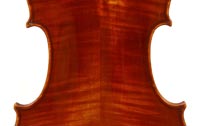Ref : 0714
A good violin, probably of
German Origin
Unlabelled
Circa 1890
This is a violin of considerable merit - it has excellent tone to the extent that most of the bigger works such as the important concertos can be played on it with satisfaction - it is responsive and does all the things a good violin should do. By way of a test I worked my way through the Brahms Concerto's first movement and found that everything responded the way it should. The violin speaks with ease and clarity throughout the full register - a rich sonorous g-string up to a clear and powerful e-string, well balanced throughout.It is nicely made of a good choice of materials - the two-piece back and ribs are of attractively flamed maple with a medium curl. The top is of excellent finely grained tone spruce - better than one commonly sees. The varnish appears to be the original, although the varnish of the top seems to be of a softer type and of a different consistency - it shows more wear and susceptibility to touch and friction. The back varnish seems more robust, but throughout it is an attractive instrument with very nice proportions along the Stradivari model. The only evident repair is to a minor crack running for about 6 cm from the top end of the treble f-hole downwards past the bridge. It's important to note that this crack does not pass under the bridge or over the soundpost. It has been correctly repaired with two cleats on the inside, and although is slightly conspicuous, it is certainly benign and poses no structural threat to the violin, nor does it affect the sound. Other than that it can be said with confidence that the violin is in very good condition throughout. Two previous owners scratched their names into the instrument - one on the button, and one near the edge to the bass flank on the back (see photos).
The violin is unlabelled and is strictly of unknown origin. However, an interesting feature is some embellishments carved into the flanks and back of the pegbox - nicely done, although it is uncertain if this was done at the time of production, or maybe added later by a good craftsman (see photos). Such embellishment is characteristic of the South of Germany, and that may point at the origin of the violin. All who have examined this violin feel it is of German origin, but I think that is simplistic - aspects of the instrument suggest it is not purely German and could be from elsewhere, maybe Eastern Europe.
It has been taken to the USA for assessment and examination - the opinion by two American authorities is that it is German from around 1900. As much as this violin's origin will probably never be established with any certainty, it has an interesting history and was rescued from certain oblivion to serve, we hope, an appreciative and worthy violinist for a long time to come.
It is sold with a receipt from Gradoux-Matt Rare Violins, LLC" in New York, stating its origin, age and value.
 |
 |
 |
||
 |
Dimensions : Length of back: 35.8 cm
Condition : Throughout in very good condition. The only discernable repair is to a 6 cm crack along the treble f-hole in the top. The crack has been correctly repaired with two cleats in the inside and is stable. It runs clear of the bridge and soundpost and poses no structural threat. The varnish on the top is somewhat worn, but appears to be the original.
Provenance : This violin was discovered in the attic of a farm near Otto's Bluff in the KZN province of South Africa. It was then sold via an antique dealership in Pietermaritzburg to its present owner. It was eventually set up by Max Peyer in Cape Town (2008), but from there went to New York for an assessment. It was seen by Christophe Landon in New York, and by Gradoux-Matt Rare Violins, also in New York. It was also assessed by Peter Prier in Salt Lake City. Present ownership withheld.
Price : Withheld
 |
 |
 |
 |
 |
 |
 |
 |
 |
 |
 |
 |
|||||
 |